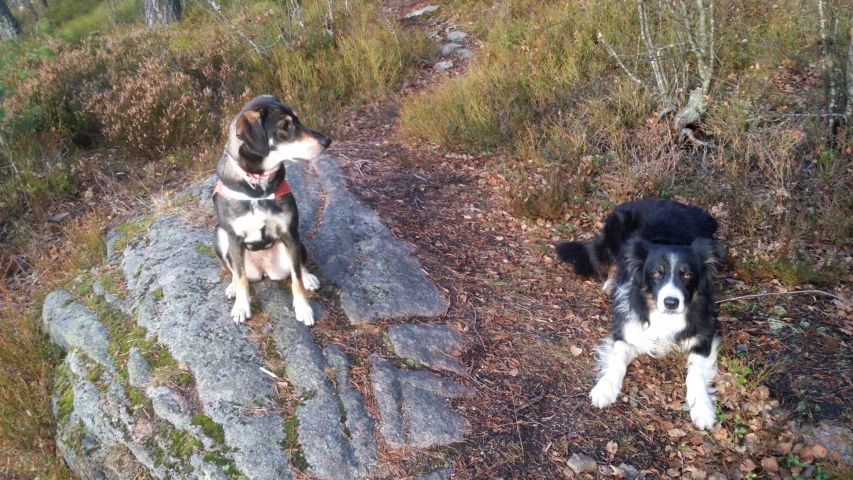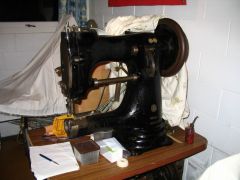-
Posts
1,591 -
Joined
-
Last visited
Content Type
Profiles
Forums
Events
Blogs
Gallery
Everything posted by Trox
-
Thanks Walter and Macca, thats was what I thought it did, just had to ask. I must confess that I use a strap around my French saddler's clamp, I get a restless leg of pressing the clamp together. Especially when I am using it for a long period of time. Of course I do most of my sewing on a sewing machine. However, If I had been hand-sewing all the time like you Walter; I am sure I had become more used to it. Tor
-
-
Thanks, perhaps you will consider selling your, if you still have it. Thanks Tor
-
Hi Rmr, where did you buy that attachment, do you know if its still available. Thanks Tor
-
Hi, Pfaff made class 28 and 27 a long time ago, who where machine with a shuttle hook for heavy threads. However, these where bottom feed machines and do not compare with todays DA 205-370 triple feed heavy machine. Pfaff made the triple feed 345 vertical hook cylinder-bed who is very similar to the DA 269, (but without a hook safety clutch) these are both medium machines. Today Pfaff only make one cylinder bed and that`s the "new" class 335. Horizontal rotating hook for medium work and threads. All above are good machine, but must be set up to sew leather. That might require new feet`s, feed dog, a new servo motor; to mention some of it.. Steve from Cobra Leather machine offers a complete range of leather working machines, from light to heavy. They are all set up for leather and ready to work. He ships everywhere and are a great person to deal with, check it out. Tor
-
Thank you Walter and thanks for the translation Sona and Thor. Walter, just to make sure. That metal hardware locks the jaws of it? I always thought it did. But when I see your neighbors son resting his foot on the pedal, I'm not sure anymore.
-
Hi, I been thinking about copying this 441 attachment for box stitching. It was either Artisan or Ferdco who came with it in the first place. The principals is of course the same, you need to have a wooden lest inside to make this work too. Tor
-
Yes there is quite a few of these Adler 120 that changed name to Singer. Must be because it had a larger foot lift that the Singer 27 B2B. The high lift Adler cl. 120 had a 40 mm foot lift. This subclass has a gear on the hand-wheel. It is very cheap priced, this are very expensive machines. Tor
-
Hi, there are two screw in the bobbin house, one Little locking screw and the tension screw that sits on the Little bobbin thread tension (leaf) spring. You got to open the first and adjust with the other; then lock it again when finished. Take care to clean out the bobbin area/hook Assembly. Make sure your top thread run in true all guides/ holes and between the top tension disk and not has jumped out of it. The thread should snap in between the two disc's on top. Check the top threading and if the thread goes true the take-up retaining spring and its function. Good luck Tor
-
It has top and bottom feed, no needle feed. The upper feed is a feeding foot. Is a machine for ruffling work, its able to feed different length on top and bottom. No reverse. Its better than a bottom feed, but without the needle feed it will mark the leather on one side. Its made for the shoe industry and are not to be confused for a 205-370 triple feed machine. However,Its still an expensive machine. Tor
-
Thank you Simon, thats very nice of you. I have to wait for the template to know the exact measurement/volume I need. The Birch finer (plywood) we have enough of here. And the tools, I have everything I need for both steel and wood. It would be an easy way to make the jaws from from birch ( or oak) plywood too, cut and glue them together (for the right thickness). Then epoxy glue in two hard-wood pieces in the mouth, to make it flat and resistant to the needles (later covered with leather anyway). You know what that Danish saddler did not like with it, perhaps it a bit big to have between your legs (if you used to horses and big motorbikes that would not be a problem) I would like to see a picture of it in use, perhaps you could ask Walter for one. Its in fact much bigger than you first would guess, without the measurements you would think it is a pony for a table top. I always thought it was a overpriced. However, when its 80 to 85 cm high, its an proper saddler's sewing clamp and you can understand the price of it. I would make mine with a bigger base plate, I can rest my feet`s on. Tor
-
Great stuff Walter, and thanks to Simon and Thor for translating; there is always some German words and technical terms I do not understand. Please note me up for a template Walter, that Swiss clamp looks better than anything else I ever seen. The hardware on Leder Louis`s model is much simpler to make than the original one. However, the exact measurements will save us some trail and error. Are the curved jaws made of one piece of hornbeam wood, that tree does not grow north of Denmark. Any other recommended wood I could use instead, otherwise I have to visit Oslo Botanical garden at night time Thanks Tor
-
No, this one is most certainly rebadged by an owner, otherwise the table would have the correct size cut out. And not been altered like this. Anyway, these bottom feed machines most likely bought in for use on canvas and such heavy fabrics. For leather they would have chosen an other subclass. I would guess this one replaced an similar Singer subclass like the 45K-1, it would make no sense otherwise. Even in the 1950`ties you would not put Singer decal on a Adler to make money on it (or perhaps it was related to the post WW2). Perhaps it came from a heavy garment factory who only used Singer`s, a machine broke down and the repair shop replaced it with what they had on hand. Perhaps the factory had a reason for only using Singer, some kind of contract with the Singerco or a government. Something like that would make sense. That or perhaps the Adler machine was not that popular in the UK when it happened. One can only speculate. Tor
-
OK, so you still miss that part? and CowboyBob do not have it either? It was just a shot from the hip. That washer you linking to looks exactly like the one on my Adler 105, I guess these parts are very similar on most machines. Perhaps the companies buying it from the same producer, I do not think they all make these tension part them self. What do you think of this Singer class 4-1 Jimi found on Ebay? Tor
-
Thats real funny, because this looks exactly like an Adler class 4. You can compare it with another 45K-1 for sale on EBay http://www.ebay.co.uk/itm/Singer-45K1-Lockstitch-Heavy-Duty-Straight-Stitch-Industrial-Sewing-Machine/111615550745?_trksid=p2047675.c100005.m1851&_trkparms=aid%3D222007%26algo%3DSIC.MBE%26ao%3D1%26asc%3D20140122125356%26meid%3Deb1c7181b994425a82deb5d85e57628f%26pid%3D100005%26rk%3D1%26rkt%3D6%26sd%3D221714659335&rt=nc And clearly see this machine is longer. Looks like its replacing a shorter 45K in the table cut out, you see the cut out for the hinge not used anymore. Looks like it has 45K or a small Adler 104 closed frame shuttle, it could also be an aftermarket one of course. The needle screw and guide belongs to a Singer. Some details do not look like a Adler class 4 head, like the hole in backside (front), perhaps its a 104 head with a Singer or Adler class 4 hand-wheel. I do not have a picture of an Adler class 4-1 to compare it too. I will not blame Singer for this job, looks like this has been done by the owner. Perhaps the 45K broke down and he needed some reliable replacement Joke aside, I really do not know what this is, its something "smelly" thats for sure. Tor
-
HI Tribo, your feed wheel should feed the material true. You need to go true the adjustment to find the zero position on the feed wheel (parallel to the knife) then work on you knife edge. You should not have to run grind stone very long, but if your edge is wrong and has burr`s. Then you must use the time it takes to make i good again. And Like Ferg says (that I wrote too) use the dresser tool on your grind stone; it should sharpen the entire edge. Well, the paper adjustment method is quit simple and is to make your feed wheel parallel to the knife. Its not a thickness adjustment! you must bring you feed wheel out again to the proper (desired) distance from the knife. Like I wrote in my post. I adjust the feed wheel distance from thin to thick leather, but leave as is for most upholstery weight of leather. Then I only have do the adjustment on the foot height. And of course; I too have to do test runs on the same material before doing the actual skiving job. Tribo, is your machine a constant speed knife or a variable speed one? Mine has a constant speed knife and variable peed feed wheel of course. If you have the first option, perhaps it will skive better on a higher speed. I thinks its possible to change the knife speed relative to the feed wheel, change the belt to another pulley (inside the machine). I do not know because thats never been an issue on my machine. Good luck Tor
-
Hi, thats right, its easier to find vintage Singer Spare part than Adler. https://www.college-sewing.co.uk/1415C%3d97800-TENSION-UNIT-COMPLETE-SEIKO-132K Is this what you are looking for? just parts of these unit are more difficult to find I think. (its Seiko, but thats good too) The Singer 29 K shuttle carrier spring # 8610 https://www.college-sewing.co.uk/8610-SHUTTLE-CARRIER-SPRING-SINGER-29K Took me 4 min. to find these parts in UK (Singer country) College Sewing has allot of stuff for industrial sewing machine, it does not matter what brand it is. But known classes like 29k and 133K, you came to right place. But next time I need something to for one of my Adler's, I will ask you to do a German search in for me; deal? It like you say its is, nothing is impossible in the world of industrial sewing machine. Strange unknown machine suddenly appears, made exclusively for one large customer. They take a suitable head from another brand and fill it with their own shafts and gears. Its like with the Adler 221 sail maker machine, DA buys clone machines and trow away their part, using their own spare part to be able fulfill a order for such a machine. So nothing surprises me any more. Tor
-
A German "Singer" man I knew this with would stir up some feelings. Perhaps, they had to use some parts they already had from another class, I do not know. There are many factors in play here, Singer did not have to clone it; just copy what they needed. There are lot of circumstantial evidence here, and when I always find such cases like the 45A, it makes you start thinking:) Thats right Shoe patcher, they both copied others in the beginning. However, in the modern sewing machine history DA is the company everybody else trying to copy. You have to invent your own stuff to be marked leading, thats what DA did. And again this are just my theories too Tor
-
Hi Tribo, I always finishing sharpening the bell knife with the burr removing tool and the grind wheel together; and moving them both away from the knife in the exact same moment. Then I stop the machine to feel with my fingers for burr`s. If you do one side after the other, it will likely form a burr on one side of the knife. The knife must be perfect to skive well, especially on thin delicate leathers. I see that my bell knife has a longer (wider) edge than yours. Perhaps you have to dress your grind stone (with the dresser tool) and then grind a longer edge on your knife (be careful not to overheat). I do not know if that helps or not, but it is important in all other types of skiving; to have the right angle on the skiving knife (I believe it does matter here too). On difficult thin leather you can use the help of some blue color (painters) masking tape. Place it on the grain side of the leather, to make sure it does not curl up when skiving. The blue color tape is easily removed afterwards. Adjust your feed wheel to have the same distance from the knife all over its curve/radius. You can use the aids of paper strips when adjusting it. Place them between the feed wheel and knife, bring the wheel closer to the knife and when you pull out the paper strips you will feel the Resistance they give. This way you can adjust the feed wheel distance to be equal all over the knives curve. Then bring the feed wheel back out to the recommended distance from the knife. I use the same distance for all weights of upholstery leather, for thicker leather you can back of the feed wheel spring pressure a bit. These skiving machines has a step learning curve,but keep practicing and you will get it right. Good luck Tor
-
Adler 69-373 it a narrow arm machine for small leather goods sewing with tex 69 thread (maximum 135 if possible). CB 3200 is a new type of budget heavy stitcher sing the 441 hook and feets (and so on). Capable of sewing heavy leather up to 1/2 inch, with up to thread size tex 415 Bonded nylon. These are very different machine, but are both triple feed cylinder beds. You should buy both. But of course its depended of the material you want to sew. Tor
-
Every one copied each other when possible. Its like today, when a popular product is out of patent protection, then its soon forgotten who made it in the first place. Anyway, Kochs Adler constructed many popular machines and Singer copied a lot of them. Here they copied the Adler class 204-64 and 205-64, then called it 45A-92 and 45A-93. They did not even bother to make their own part list for, so they copied those too http://parts.singerco.com/IPpartCharts/45A92.pdf http://parts.singerco.com/IPpartCharts/45A93.pdf its the original German Adler part lists. The 204/205 are successors of the class 4 and 5, who later became 104 and 105. Class 4 and 5 are the same machines as the 45K. The number "45" contains 4 and 5 together, and is not the machine model number 45 Singer made.(Its not a logical class number for Singer) And the class 45K are both cylinder bed and flatbed machines together. Where came this class number from? Its only one logical explanation, they stole it from Adler. This is my (conspiracy) theory anyway You cannot find such behavior in the history of the DA company. Of course everybody starts with copying others, but when Adler became better they made their own design. Singer bought up allot of small good companies and carried on copying when they needed too. Business is business and when its legal it alright. There are many who will not agree with me in this theory. They both made/make good sewing machines who are copied by others today.
-
Hi, like I said before Singer was the one doing the copying, not Adler. Tor
-
Yes you might use what needle you like but still TKT 15 is only Tex 180 and not 207 in polyester, as in my example. (TKT 207 or 210 is TKT 13). I see this in Cowboy Bob`s web page You might use a 160 needle for tex 207, but it does not make it in to a tkt 15 size in polyester. Tex is a weight measurement and Nm is a length measurement. Ticket numbers are the manufacturers reference numbers unique to each thread type and all threads types has different weight. Therefore, ticket number are different for bonded nylon, nylon, cotton, corspun cotton, lubricated polyester and regular polyester (to mention some). Thats why I told you the threads types it applied for was polyester in this case A very easy calculation based on three unknowns, its a jungle. Especially when we cannot agree on what system to use on basic length, weight and numbers. I think somebody has to decide for us, because we will never agree on whats best.
-
Thats a very good price for an 467 (if in good sewing condition and not a worn out old factory machine) Even If you have to buy a new hook, its still a good price for a 467. Tor
-
OK Dogface, (nice dog by the way) thats a grease job for sure. Or mine has a little brass reservoir I use leather fat in (Gold Quality by the way.) Good for worn out patcher shuttles as well, keep them in place
- 9 replies
-
- belt slippage
- pully bearings
-
(and 1 more)
Tagged with:





